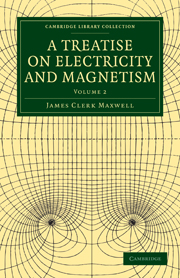Book contents
- Frontmatter
- Contents
- PART III MAGNETISM
- CHAPTER I ELEMENTARY THEORY OF MAGNETISM
- CHAPTER II MAGNETIC FORCE AND MAGNETIC INDUCTION
- CHAPTER III PARTICULAR FORMS OF MAGNETS
- CHAPTER IV INDUCED MAGNETIZATION
- CHAPTER V MAGNETIC PROBLEMS
- CHAPTER VI WEBER'S THEORY OF MAGNETIC INDUCTION
- CHAPTER VII MAGNETIC MEASUREMENTS
- CHAPTER VIII TERRESTRIAL MAGNETISM
- PART IV ELECTROMAGNETISM
- INDEX
- Plate section
CHAPTER VII - MAGNETIC MEASUREMENTS
Published online by Cambridge University Press: 05 July 2011
- Frontmatter
- Contents
- PART III MAGNETISM
- CHAPTER I ELEMENTARY THEORY OF MAGNETISM
- CHAPTER II MAGNETIC FORCE AND MAGNETIC INDUCTION
- CHAPTER III PARTICULAR FORMS OF MAGNETS
- CHAPTER IV INDUCED MAGNETIZATION
- CHAPTER V MAGNETIC PROBLEMS
- CHAPTER VI WEBER'S THEORY OF MAGNETIC INDUCTION
- CHAPTER VII MAGNETIC MEASUREMENTS
- CHAPTER VIII TERRESTRIAL MAGNETISM
- PART IV ELECTROMAGNETISM
- INDEX
- Plate section
Summary
449.] The principal magnetic measurements are the determination of the magnetic axis and magnetic moment of a magnet, and that of the direction and intensity of the magnetic force at a given place.
Since these measurements are made near the surface of the earth, the magnets are always acted on by gravity as well as by terrestrial magnetism, and since the magnets are made of steel their magnetism is partly permanent and partly induced. The permanent magnetism is altered by changes of temperature, by strong induction, and by violent blows; the induced magnetism varies with every variation of the external magnetic force.
The most convenient way of observing the force acting on a magnet is by making the magnet free to turn about a vertical axis. In ordinary compasses this is done by balancing the magnet on a vertical pivot. The finer the point of the pivot the smaller is the moment of the friction which interferes with the action of the magnetic force. For more refined observations the magnet is suspended by a thread composed of a silk fibre without twist, either single, or doubled on itself a sufficient number of times, and so formed into a thread of parallel fibres, each of which supports as nearly as possible an equal part of the weight.
- Type
- Chapter
- Information
- A Treatise on Electricity and Magnetism , pp. 88 - 119Publisher: Cambridge University PressPrint publication year: 2010First published in: 1873

